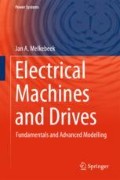Abstract
In this chapter we discuss the synchronous machine mainly from its traditional function as generator. Motoring, in particular with permanent magnet synchronous motors, is treated in a later chapter. The first section gives an overview of the main two rotor types and their properties. In the following section, the smooth rotor synchronous machine is treated in detail, including armature reaction, phasor diagrams, equivalent circuits, current diagram, torque but also a thorough discussion of the non-linear generator characteristics. In the next section, salient pole synchronous machines are treated. One of the last sections is devoted to the operation (mainly as generator) on an infinitely strong grid.
Access this chapter
Tax calculation will be finalised at checkout
Purchases are for personal use only
Notes
- 1.
The slots are usually omitted at the centre of the poles, as the mmf of these slots would not add much to the field but would introduce additional reluctance.
- 2.
The subscript p is used whenever quantities are referred to the armature; thus although this emf results from a DC field current (‘f’) we use the subscript ‘p’.
- 3.
This is the emf for all windings or conductors in series of one single pole-pair.
- 4.
One could also consider the phasors for the time functions \(f_{..}(0,t)\) with \(x=0\) along the axis of the reference phase.
- 5.
There also exists a complex time representation, which is nothing else but the phasor multiplied by \(\exp (j\omega t)\).
- 6.
Please, compare the phasor and space vector representations of both \(\hat{A}\cdot \cos (\frac{x\pi }{\tau _{p}}-\omega t-\varphi )\) and \(\hat{A}\cdot \cos (\frac{x\pi }{\tau _{p}}-\omega t)\).
- 7.
In the complex space plane, we choose the counter-clockwise direction as the positive rotation direction, like for the complex time plane.
- 8.
Many authors choose the q-axis in the other direction, thus \(90^{\circ }\) leading the d-axis; however in a 1968 IEEE recommendation the \(90^{\circ }\) lagging direction is preferred.
- 9.
Using a variable auto-transformer between the grid and the synchronous machine.
- 10.
The leakage reactance in per unit is about 0.2; limiting the armature current to 1 or 2 p.u. results in a resulting emf which remains on the linear part of the no-load characteristic, well below saturation.
- 11.
I.e. constant excitation current for a constant saturation level.
- 12.
With the URS at the electrical side, the load angle is positive when the terminal voltage is leading the rotor voltage.
- 13.
Prove this by considering the equation of motion; you will also have to relate a change of the load angle with an increasing or decreasing speed, e.g. for a constant supply frequency.
- 14.
This triangle is called the Potier triangle; for a given machine (\(X_{\sigma }\) and \(\alpha \)) these triangles are always similar; the triangle is also called the short-circuit triangle, see the triangle ABC.
- 15.
From the short-circuit characteristic the excitation current corresponding with a short-circuit current I can be derived and thus the point A on the short-circuit triangle can be found. From the point Q on the horizontal through M with QM \(=\) OA a line parallel with the linear initial part of the no-load characteristic the point N is found. This is known as the method of Fisher-Hinnen.
- 16.
For a smooth rotor synchronous machine this would result in a reversal of the torque as the polarity of the rotor poles switches.
- 17.
Please, try to explain! Hint: when a complex impedance \(\underline{Z}\) tends to zero, it doesn’t matter what the phase angle is.
- 18.
In the load characteristics, draw a horizontal line corresponding to the given terminal voltage. Consider then the Potier triangles with point P on the no-load characteristic and the sides QM on this horizontal line.
- 19.
In the load characteristics, draw a vertical line corresponding to the given excitation current. Consider then the Potier triangles with point P on the no-load characteristic and the sides QP on this vertical line.
- 20.
Because of the lower winding factors for higher harmonics.
- 21.
An additional problem is that, in general, the saturation characteristic in the q-axis is not known and cannot easily be measured.
- 22.
Normally, a q-axis excitation winding is not present; the only way to record a q-axis saturation characteristic is to use AC excitation with all AC mmf in the q-axis. However, this is problematic as well because of stability issues (please explain).
- 23.
Which is caused by the large air-gap in the inter-polar space of the q-axis.
- 24.
This is in fact also an approximation or linearisation as adding these emfs is equivalent to adding induction values which is strictly not allowed in case of saturation.
- 25.
Alternatively, one may use the scalar form of these equations for d- and q-axes but then the risk for errors is greater.
- 26.
In B, draw the vector \(\underline{BF}=jX_{d}\underline{I}\); the endpoint E of the vector \(\underline{BE}=jX_{q}\underline{I}\) is on the q-axis and the projection D of F on the line OE yields the emf \(\underline{OD}=E_{p}\).
- 27.
Indeed, verify that \(\underline{I}_{d}\) and \(\underline{I}_{q}\) cannot be replaced by \(\underline{I}\) when \(X_{d}\ne X_{q}\).
- 28.
Indeed, in reality the grid is not ‘infinitely’ strong and the generator active and reactive power exchange will affect frequency and voltage level of the grid.
Author information
Authors and Affiliations
Corresponding author
Rights and permissions
Copyright information
© 2018 Springer International Publishing AG
About this chapter
Cite this chapter
Melkebeek, J.A. (2018). The Synchronous Machine. In: Electrical Machines and Drives. Power Systems. Springer, Cham. https://doi.org/10.1007/978-3-319-72730-1_5
Download citation
DOI: https://doi.org/10.1007/978-3-319-72730-1_5
Published:
Publisher Name: Springer, Cham
Print ISBN: 978-3-319-72729-5
Online ISBN: 978-3-319-72730-1
eBook Packages: EnergyEnergy (R0)

